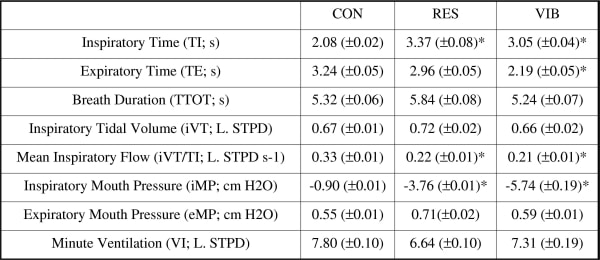Vibration stimulation has been applied to the ventilatory musculature with demonstrable increases in ventilatory motoneurone activity in rabbits (Jammes et al. 2000) and increased maximal ventilatory force generating capacity in humans (Sumners et al. 2007). Until now the effects of vibration, applied systemically through the air as it passes into the lungs on spontaneous ventilatory control have not been quantified. The aim of the present investigation was to assess the effects of vibration and flow-resistive loads upon such control. Ten healthy human subjects with no history of respiratory disease participated in the study, which had local University Ethics Committee approval. On an initial visit, each subject was familiarised with the experimental equipment and exposed to vibration induced via rapid-oscillatory (18Hz) airflow braking forces (21 cmH20 l s-1 youbreathe, Exoscience Ltd, London) and a resistive load (length 100mm; internal diameter 5mm; 19 cmH20 l s-1) matched to the inspiratory mouth pressure during vibration stimulus. On three subsequent visits the subject sat in a comfortable chair and breathed through a respiratory circuit via a mouth piece whilst using a nose clip. After 10 breaths to re-familiarise with the equipment, 30 breaths were performed with either resistive loading (RES), vibration stimulus (VIB) or neither (CON). A further 30 breaths were performed with the stimulus removed to ensure responses were reversible. Subjects mouth pressure was measured via a pressure transducer (Range ± 10 cmH20) and induced airflow via a heated pneumotachograph, both sampled at 200Hz (CED 1401), from which breath-by-breath parameters were calculated (Table. 1). Student’s paired t-tests were performed between CON, RES and VIB with p<0.05 indicating significance. Inspiratory vibration and matched resistance induced TI prolongation, iVT/TI reduction and iMP increments. In addition, inspiratory vibration alone resulted in a significant shortening of TE. This suggests an altered expiratory drive, but with no change in expiratory mouth pressure and ventilation this could possibly be facilitated by bronchodilation.
University of Leeds (2008) Proc Physiol Soc 10, PC6
Poster Communications: The effect of systemic vibration upon spontaneous tidal breathing
D. P. Sumners1, S. P. Hunter1, D. A. Green2
1. Sport and Exercise Science Research Centre, London South Bank University, London, United Kingdom. 2. Department of Physiology, Kings College London, London, United Kingdom.
View other abstracts by:
Table. 1. Population (n=10) mean (&#177; SEM) breath-by-breath parameter responses were compared between control (CON) inspiratory resistive loading (RES) and inspiratory vibration (VIB). * Indicates significant difference vs. CON.
Where applicable, experiments conform with Society ethical requirements.

